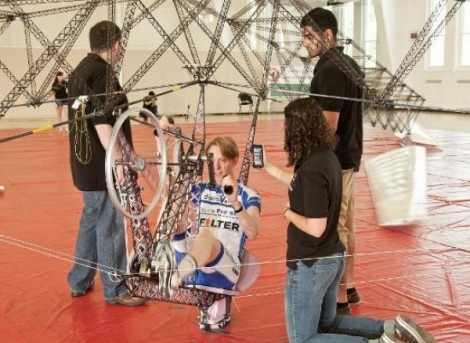
If you decide to fly into town on this bicycle-powered quadcopter your arms and legs really will be tired. That’s because this athlete had to give it his all to power the rotors through the foot pedals and the hand cranks. You can see just one of the rotors on the right side of the background. Yeah, this thing is big!
You’re looking at the Gamera II, a craft developed by students at the University of Maryland. About a year ago they were showing off the first version of the aircraft. With the passing of the year comes the breaking of world records as a different rider manages to keep it up for 50 seconds in the video after the break. Although the structure is huge (over 100 feet across) the building materials and techniques let it weigh in at only 71 pounds.
It still looks like way to much physical work for us. We’re sticking to the pedal-powered hydrofoil as our dream transport.
[via Reddit]















You wouldn’t catch me standing in the middle of those whirling blades! They don’t look to be rotating at a huge number of RPM but the tip speed is enormous…
It looks like the blades are still using ground effect to get off the ground. I don’t think this could ever achieve more than the 12″ – 18″ of height it shows in the video.
I think the Sikorsky prize they’re trying to win requires them to hover at 3 meters minimum.
The problem is that they really don’t have the power budget for it. The less air you move, the more you have to accelerate it to create the reaction force, so the more power you need, and with about 100 kg of mass to lift, they need 5-6 kW of power with reasonably sized propellers. A human can supply only 1-2 kW at maximum for a few seconds.
The wingspan of the Daedalus human powered airplane is about 34 m (111 ft 6 in) and it weighs about the same as their helicopter, which is an indication of how large the rotors must be to keep it up under human power. With backwash and other inefficiencies added, I’d guess you need a propeller at least 50 meters in diameter or something comparable in area to do it.
Looks like its only in ground effect which is where wings get more lift when they’re closer to the ground. Cool but not impressive enough. If it was a few feet off the ground, than it would be awesome.
I wonder how the efficiency of those large blades are compared to smaller ones. The airflow is probably proportional but the supporting arms that extend outwards probably just add unnecessary weight
In rotating airfoils you get most of the lift from the tip section. The middle section only mostly adds drag. That’s why they used ultralight support structure to extend the radius of their blades.
Really nice concept and execution but the applications are limited. The “wingspan” of such device is enormous to prevent being anywhere useful!
This is actually a skirtless hovercraft.
If they wanted to accomplish almost identical performance with improved efficiency, they could simply duct the rotors with a fabric or plastic skirt, and fly just as high, with significantly less effort.
Helicopters are very inefficient. If the same amount of thrust was applied to drive lightly loaded wings, one could greatly improve the performance envelope whilst flying in ground effect.
Sooner or later someone will get the bright idea to use bicycle pedals to compress air (or charge cells), and then take great pleasure in pedaling for three days in exchange for a thrilling three minute pneumatic or electric flight.
I’m holding out for vedic mercury engines.
While hilariously inefficient, this is being done to win a specific prize, the Sikorsky Prize
http://en.wikipedia.org/wiki/Sikorsky_Prize
The actual goal is to get a flight duration of 60 seconds and reaching an altitude of 3 meters (9.8 ft) while remaining in a 10 meter (32.8 ft) square.
Currently, using a really, really light aircraft (only 4.4 pounds for each of those rotors!) and the ground effect, Gamera II *almost* manages to get the 60 second part, and that would be 3 times better than the previous record. Yeah, it’s a hard problem that probably doesn’t have a solution right now, but imagine if it did. Whatever someone figures out to make that go would change a lot of aircraft design almost immediately.
Disclaimer: I’m a UMD student (not involved in this project) go terps!
Nice job, but it will not be used by many people… Those who decide to use this bicycle must be in a very good shape…
not as much fun looking as the other human powered flying machine, but at least its real.
http://www.youtube.com/watch?v=GYW5G2kbrKk&feature=player_embedded
That was nice. Does it come in an electric-powered variety?
I am suddenly taken back to all those failed flying contraptions clips, viewed with yakity sax playing in the backgroud.
seriously cool though, but i won’t ever try it myself, i like to keep my hands behind the keyboard and my heart in my chest.
“but at least its real.”
Nope:
http://www.bbc.co.uk/news/world-europe-17487366
He was referring to the machine in the article ;)
In other words: The one in the article doesn’t look as fun as the fake one but the one in the article is at least real.
…NOT REAL…
Yes, the one in this article is real (not the human bird one). Please read my explanation above if you have a hard time understanding English.
4 questions:
1: How long can you pedal that thing before you knock yourself out on the hand pedals?
2: Where would you ever park that thing?
3: How does he stay on that thing(not a problem at 5 inches, but anything higher and he’s going to end up on his head)
4: How would you ever steer that, all your appendages are already in use?
BTW, whoever mentioned hovercraft, mine does fly higher than that, for real. I can mount a 6″ curb no problem.
This has been attempted and has had a better result by another group
[youtube http://www.youtube.com/watch?v=aR2CV1OeUdU&w=420&h=315%5D
Also on a side note, a proper gear ratio would help as the torque doesn’t seem to be adequate later on when the rider is maxed on RPMs of the pedals
Can’t tell from the Wikipedia article but would it be kosher to have the rider pedal to wind up a spring and then release it to drive the rotors? You could pedal a while, rest a while, pedal some more and then let all the energy go in a short burst. It would still be “Human Powered”.
Nope. By definition the Sikorsky prize must be for a completely human powered helo. Any sort of energy storage is prohibited including springs.
Energy storage as in a flywheel? Of which there are many shown.
Well, that also wouldn’t make sense. I’m pretty sure the best power output (as viewed over time) would be done by a consistent sustained effort, instead of doing it in bursts. The human body is designed this way. That is why there aren’t athletes who go for a run by sprinting, taking a break and sprinting again.
Guess not. The rules state:
4.1.4 No devices for storing energy either for takeoff or for use in flight shall be permitted. Rotating aerodynamic components, such as rotor blades, used for lift and/or control are exempt from consideration as energy storing devices.
Oehmichen anyone?
http://en.wikipedia.org/wiki/Etienne_Oehmichen
thats cool but i can’t wait till someone puts a motor and RC on it
Sorry but that is not flight! Hovercraft or ground-effect possibly. With flight the bike would have kept climbing – it stopped climbing as soon as it got to a height where the ground-effect stopped.
That’s my take on this — it’s not a copter so much as it is a rotary WIGE…
Though I have often wondered if a lightweight WIGE could be human powered… with todays lightweight materials and already having human powered planes making flights of over 600 feet going back to the `60’s, and flights of durations similar to this ‘copter’ going back to the late `20’s, the added lift provided by ‘ground effect’ could result in something fairly impressive.
i think it is fake!!
simlar to birdman video!!
http://www.dailymail.co.uk/sciencetech/article-2119052/Dutch-flying-birdman-Jarno-Smeets-admits-viral-video-FAKE.html
if only the could build a smaller version